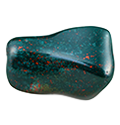
The second birthstone for March is bloodstone, a dark-green gemstone flecked with vivid red spots of iron oxide. Generally found embedded in rocks or riverbeds as pebbles, primary sources for this gemstone are India, Brazil, and Australia.
Bloodstone is also called heliotrope, a word from the ancient Greek that means “to turn the sun.” Many believe it was probably named as such because of ancient ideas about how minerals reflect light. In fact, some believed that the sun itself would turn red if this gemstone was put into water.
Bloodstone is sometimes known by another name—Blood Jasper—although it’s actually chalcedony, which is a cryptocrystalline quartz. There are two forms of bloodstone: heliotrope, which is more transparent with red spots, and plasma, which is more opaque and has little or no red spots.
For those looking for good-quality bloodstone gems, a solid green color with visible veins of red is usually considered the best. It also comes in many shapes and cuts, including traditional cuts like emerald, oval, and cushion.
Bloodstone may not have the overt beauty of aquamarine, but many people value this gemstone for its symbolism and other properties.
Copyright © 2024 American Gem Society